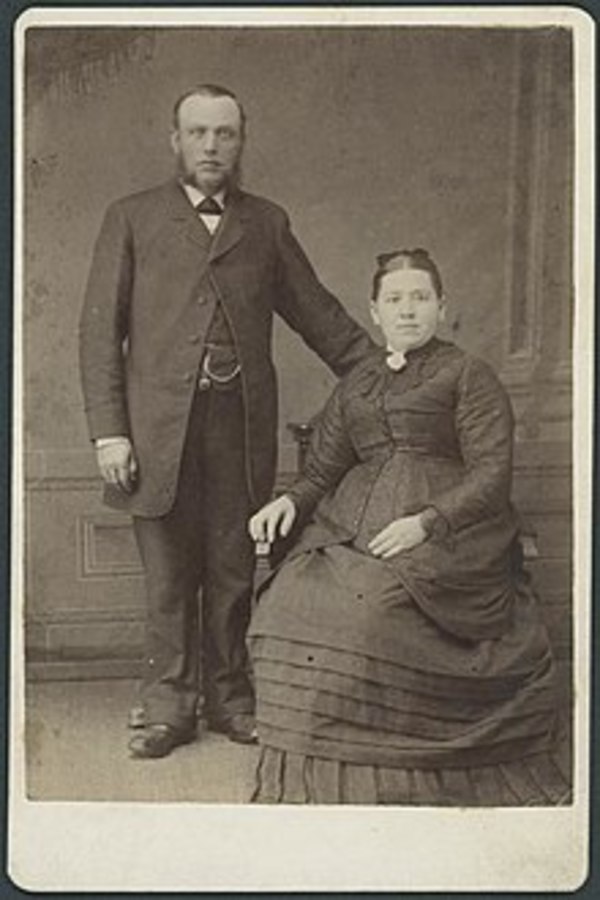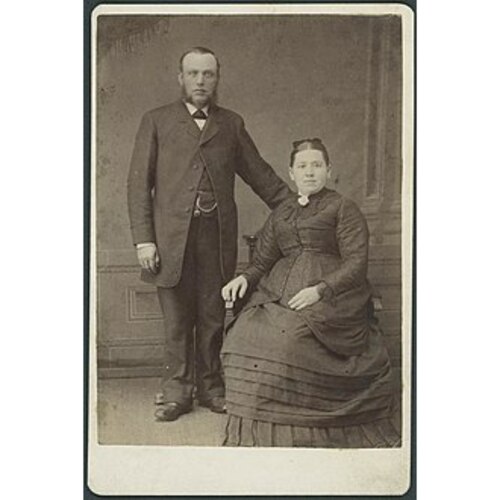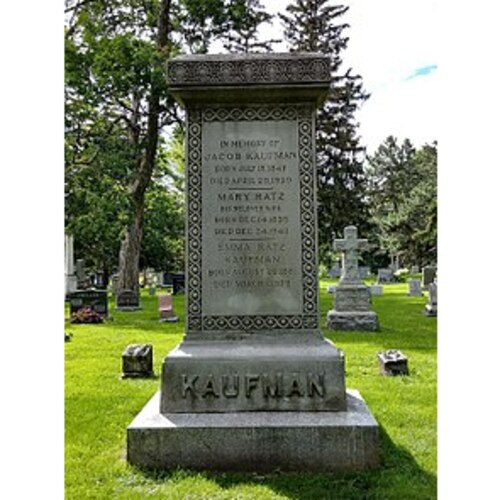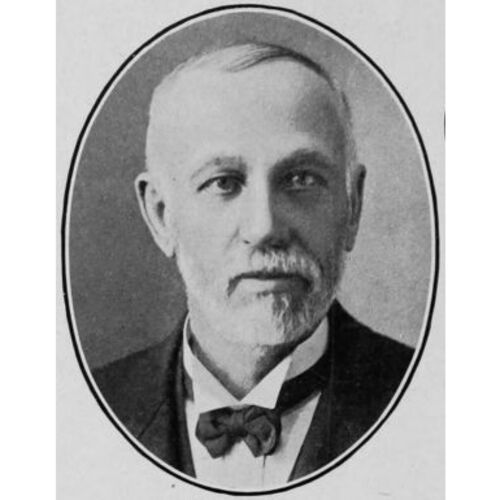
Source: Courtesy of Wikimedia Commons
KAUFMAN, JACOB, carpenter and manufacturer; b. 15 July 1847 in North Easthope Township, Upper Canada, son of Joseph Kauffman and Anna Stroh; m. there 5 March 1877 Mary Ratz, and they had seven children, of whom two sons and two daughters reached adulthood; d. 20 April 1920 in Kitchener, Ont.
Jacob Kaufman’s father, a native of Bavaria (Germany), emigrated to the United States in 1827. After working as a baker in New York City, he moved to Upper Canada and acquired land from the Canada Company in North Easthope west of Hamburg (New Hamburg). Kaufman’s mother, originally from Alsace, married Joseph Kauffman in 1842. The third of ten children, Jacob worked on the family farm as a youth and could attend school only during the winter; he displayed “splendid natural mental endowment.” Still on the farm in 1871 but listed as a carpenter, he left to become a sawyer in the sawmill of Henry Ratz in nearby Gads Hill. In March 1877 Kaufman married Ratz’s daughter and a month later they moved to Berlin (Kitchener), a village of strong Germanic background.
In partnership with his father-in-law, whom he later bought out, Kaufman secured in December 1877 an exemption from municipal taxation and soon thereafter established a planing mill and a sash-and-door factory. Aided as well by linkage to the Grand Trunk Railway, the operation expanded and in 1881 the tax exemption of Ratz and Kaufman was renewed. In 1888 a new brick factory was constructed. When the region’s supply of wood began to dwindle, Kaufman bought a large area of forest in Muskoka. From 1902 logs were cut there at mills at Rosseau Falls and farther north at Trout Creek, where Kaufman also produced wood alcohol and charcoal. When Nelson and Milton Good began producing automobiles in Berlin in the early 1900s, the Kaufman plant fashioned about 20 wooden bodies, which apparently were never used. Locally Kaufman’s goods were transported by a horse-drawn wagon until 1909, when a motor car was converted into a truck. In 1916 the business was incorporated as Jacob Kaufman Limited.
In addition to his lumber operations, Kaufman was a founder of the rubberized footwear industry in Berlin, an offshoot of its leather and felt industries. With A. L. Breithaupt and Louis Weber, he became associated with building contractor George Schlee, who had inspected factories in Ohio, and in May 1899 they organized the Berlin Rubber Manufacturing Company Limited. It prospered, but Kaufman fell out with his partners, reputedly because he wanted to give a raise to its aspiring bookkeeper, Talmon Henry Rieder. As a result, in the spring of 1903 he and Rieder started another firm, Merchants Rubber; it made rubberized garments for fishermen and miners as well as footwear. In 1907, after Berlin Rubber and Merchants had been absorbed by Canadian Consolidated Rubber of Montreal, Kaufman and his son Alvin Ratz formed Kaufman Rubber Company Limited, which became one of Canada’s largest producers. It continues today as the Kaufman Footwear division of William H. Kaufman Incorporated.
Although Kaufman had no interest in political office, he was committed to the public development of Berlin. As a member of its light commission from April 1905 to January 1910, he supported municipal expenditure to secure electricity through the Hydro-Electric Power Commission of Ontario. Also a member of the water commission, he sat on the committee that established the town’s first sewage disposal system. In the fervour of wartime, such progress was overshadowed by the acrimonious, anti-German debate over Berlin’s name-change to Kitchener, which Kaufman first supported but then opposed. From a business perspective, at a meeting of the local Employers’ Association in March 1916 he observed that his companies had encountered little difficulty selling goods with a Berlin association. Certainly the change, which passed narrowly in a city referendum in May, did nothing to diminish Kaufman’s civic devotion: in 1917 he funded the construction of a nurses’ home near the general hospital.
The Kaufmans were lifelong members of Zion Evangelical Church: a trustee for 35 years, Jacob regularly attended the Canadian conferences of the Evangelical Association; Mary headed Zion’s women’s society. In addition, she was president of the local Children’s Aid Society and Young Women’s Christian Association, and was a member of the National Council of Women of Canada, the Women’s Hospital Aid Association of Ontario, and the Woman’s Christian Temperance Union. Her influence is visible in the career of her daughter Emma Ratz in the YWCA in Japan and Canada.
Jacob Kaufman died in 1920 and was described in the Kitchener Daily Record as “Kitchener’s industrial wizard,” whose “career is a most unique one even in our community where men who do things abound. . . . He was prepared to take a dare.” Between 1909 and 1919 this “plain spoken sociable man” had gifted his wife and four surviving children with more than $602,000; at his death he left them an estate worth almost $279,000. Milton Ratz Kaufman subsequently assumed control of the planing and lumber mills while Alvin, who would gain attention through his promotion of birth control and eugenics, took over Kaufman Rubber.
AO, RG 22-214, no.7694; RG 80-5-0-68, no.8940. NA, RG 31, C1, North Easthope Township, [Ont.], 1861, Ward 1: 7; 1871, div.2: 12 (mfm. at AO). Perth Land Registry Office (Stratford, Ont.), North Easthope Township, Deeds, nos.1590–92, 2488, 2500, 2503, 4311, 4313 (mfm. at AO). Kitchener Daily Telegraph (Kitchener, Ont.), 21 April 1920. Berlin, Ontario (Berlin [Kitchener], 1912). W. R. Chadwick, The battle for Berlin, Ontario: an historical drama (Waterloo, Ont., 1992). John English and Kenneth McLaughlin, Kitchener: an illustrated history (Waterloo, 1983). Industrial Canada (Toronto), 21 (1920–21): 158. J. E. Middleton and Fred Landon, The province of Ontario: a history, 1615–1927 (5v., Toronto, 1927–[28]), 3: 185–87. W. V. Uttley, A history of Kitchener; Ontario (Kitchener, 1937; repr. [Waterloo, 1975]).
Cite This Article
Lynn E. Richardson, “KAUFMAN, JACOB,” in Dictionary of Canadian Biography, vol. 14, University of Toronto/Université Laval, 2003–, accessed December 30, 2025, https://www.biographi.ca/en/bio/kaufman_jacob_14E.html.
The citation above shows the format for footnotes and endnotes according to the Chicago manual of style (16th edition). Information to be used in other citation formats:
| Permalink: | https://www.biographi.ca/en/bio/kaufman_jacob_14E.html |
| Author of Article: | Lynn E. Richardson |
| Title of Article: | KAUFMAN, JACOB |
| Publication Name: | Dictionary of Canadian Biography, vol. 14 |
| Publisher: | University of Toronto/Université Laval |
| Year of publication: | 1998 |
| Year of revision: | 1998 |
| Access Date: | December 30, 2025 |





